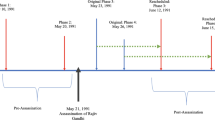Abstract
Numerous countries are heading toward digital infrastructures. In particular this new technology promises to help support methods for elections. However, one should be careful that such an infrastructure does not hinder the voting and representation issues. On the contrary, it should support those issues and help citizens have a clearer picture of the underlying mechanisms. This paper deals with the limits of voting procedures as they are described in classical collective choice theory and reflects on ways to aggregate electronic votes stemming from various individuals that would be at the same time democratic, decisive and rational which is not feasible when candidate rankings alone are taken into account. This paper shows how electronic voting procedures could improve the situation by introducing preference-based votes.
Similar content being viewed by others
References
Arrow, K. J. (1963) Social Choice and Individual Values. 2nd edn. Wiley, New York
Blair D. H., Pollak R. A. (1982) Acyclic Collective Choice Rules. Econometrica 50: 931–943
Blau, J. H. (1972) A Direct Proof of Arrow’s Theorem. Econometrica 40: 61–67
Dubois D., Prade H. (1988) Possibility Theory: An Approach to Computerized Processing of Uncertainty. Plenum Press, New York
Dubois, D. and Koning, J.-L. (1991) Social choice axioms for fuzzy set aggregation. Fuzzy sets and systems 43(3), 257–274
Fung L. W., Fu K. S. (1975) An Axiomatic Approach to Rational Decision Making in a Fuzzy Environment. In Zadeh L. A., Fu, K. S., Tanaka, K. and Shimura, M. (eds), Fuzzy Sets and Their Applications to Cognitive and Decision Processes. Academic Press, New York 227–256
Hansson B. (1969) Group Preferences. Econometrica 37: 50–54
Moulin, H. (1988) Axioms of Cooperative Decision-Making. Cambridge University Press, UK
Plaza, E. (2004). Technologies for Political Representation and Accountability. EU-LAT Workshop on e-Government and e-Democracy. Santiago, Chili, 99–107
Silvert W. (1979) Symmetric Summation: A Class of Operations on Fuzzy Sets. IEEE Transactions on Systems, Man and Cybernetics 9: 657–669
Yager, R. R. (1989). On the Logical Representation of Social Choice (Multi-agent Aggregation). Technical Report MII-811, Machine Intelligence Institute, Iona College, New Rochelle, NY
Author information
Authors and Affiliations
Corresponding author
Rights and permissions
About this article
Cite this article
Koning, JL., Dubois, D. Suitable Properties for Any Electronic Voting System. Artif Intell Law 14, 251–260 (2006). https://doi.org/10.1007/s10506-006-9000-6
Published:
Issue Date:
DOI: https://doi.org/10.1007/s10506-006-9000-6




